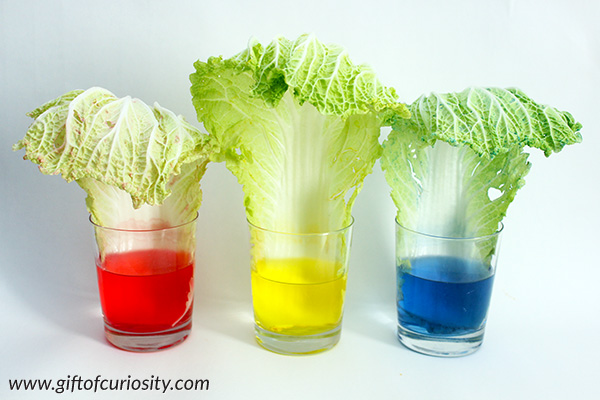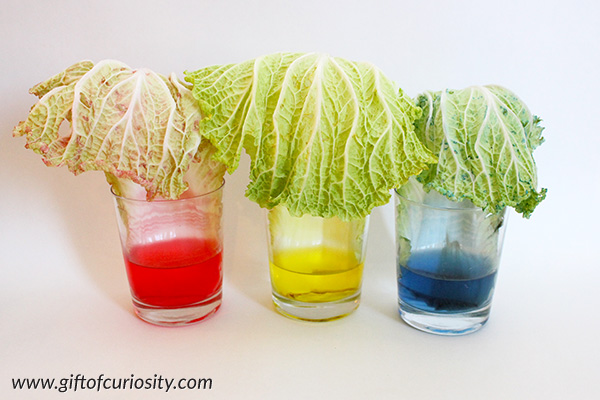This post may contain affiliate ads at no cost to you. See my disclosures for more information.
This cabbage experiment is an easy botany activity to show kids how plants get water into their leaves. With this activity, kids will be able to visually see how the water in the cup is taken up the stem and sent to all parts of the leaf.
This is also a great activity to spark a discussion about the importance of having access to clean water so that the foods we eat will be safe and healthy for us.
Note: For more botany lessons for kids of all ages, see my botany unit study page.

To do this cabbage experiment, you will need the following materials:
- Three large leaves from a napa cabbage
- Three glasses
- Water
- Liquid watercolor paints (food dyes would also work well)
I stuck one leaf into each of three glasses filled with colored water. I chose to do red, yellow, and blue.
(Although I liked the idea of using the three primary colors, in hindsight yellow wasn’t the best choice as it doesn’t produce the darkest color in the leaf.)

Two days later there was a slight drop in the level of water in the glasses and noticeable color changes in the leaves.

Around the edges of the leaf we could see a lot of red color.

Looking closely we could see evidence that the yellow dye was also creating color change, but the results were not as visible.

The changes to the blue leaf were quite dramatic. It was fun to see how quickly the leaves changed colors!

We decided to keep the leaves in the water for an additional three days. We noticed the water level in the glasses getting lower. At the same time, we noticed even more color in the cabbage leaves.

Look at all the red color in this leaf!

And if you look closely you can see evidence that this leaf is turning more yellow as well.

This leaf also showed even more blue color than before.

This is a great activity to help kids see visually that leaves take water up their stems and distribute that water to all parts of the leaf.
This activity really got me thinking about the phrase “You are what you eat.”
If our food is irrigated with low quality water (such as waste water or water with toxins in it), all of that junk will end up in the food we eat. And we probably wouldn’t even realize it. Yikes!
This is just another reminder about the importance of clean water and protecting our water sources.
More botany resources for kids
More botany posts from Gift of Curiosity:
- Dissecting flowers
- Sprouting seeds
- Do seeds need light to grow?
- How leaves breathe
- Why do leaves change colors?
- Gardening do-a-dot printables
- Leaf rubbings book
For more botany activities for kids of all ages, see my Botany Unit Study page and my Botany Pinterest Board.




